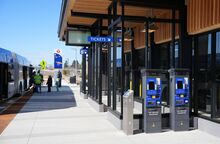Ames project is transforming transportation in the Coachella Valley
Ames Construction crews in California are building CV Link 3/4/5 in the cities of Palm Springs, Indio, and Coachella. The project includes 8.7 miles of concrete pathway for pedestrians, bicycles, and low-speed electric vehicles.
Since 2020, Ames has constructed various segments of CV Link. The corridor enhances connectivity throughout the Coachella Valley by making alternative modes of transportation safer and more convenient.
The work scope includes excavation, embankment, and grading for the concrete pathway and access points with seeded glass concrete. Crews are also installing architectural and service elements such as pathway lighting, metal railing, landscaping, shade canopies, water foundations, benches, and trash/recycling receptacles.
Grade crews achieved a major milestone in 2024 by completing the excavation and embankment of more than 30,000 cubic yards of material. The challenge in this part of the project involved determining the earthwork quantities, which were different based on existing field conditions, along with ensuring that proper compaction was achieved in the dry sandy soil conditions that exist in the desert environment.
“Our grading crew understood that to achieve the compaction requirements of the dry sandy soils, the soils needed to be scarified in 1,000-foot sections. Crews then oversaturated the sections with water, blended the material, regraded, and compacted,” explains Project Manager Doug Westbrook. “This grading operation ensured that the compaction tests would meet the testing requirements.”
Temperatures in the Coachella Valley in the summer months can soar to 115-120 degrees. The project team emphasized extreme heat awareness, specifically steps to prevent heat exhaustion. Superintendents and foremen ensured that field crews took their required breaks and had access to shaded canopies and hydration stations.
“During weekly safety meetings, we continuously explained and educated the crews on how to prevent and be aware of heat exhaustion,” Westbrook says. “This included recommendations regarding the elimination of energy drinks and encouraging proper hydration before and after work shifts. We also provided electrolyte packets for the crews that could be added to their water bottle as an extra measure to prevent heat exhaustion.”
Working with Project Superintendents John Kayser and Dave Johnston has been especially enjoyable, Westbrook adds.
“They both are very good at what they do and ensure that their crews understand that both safety and production are a part of every activity. In challenging situations, they can still bring out the fun with their crews, which allows them to maintain a sense of teamwork even in those difficult situations.”
















